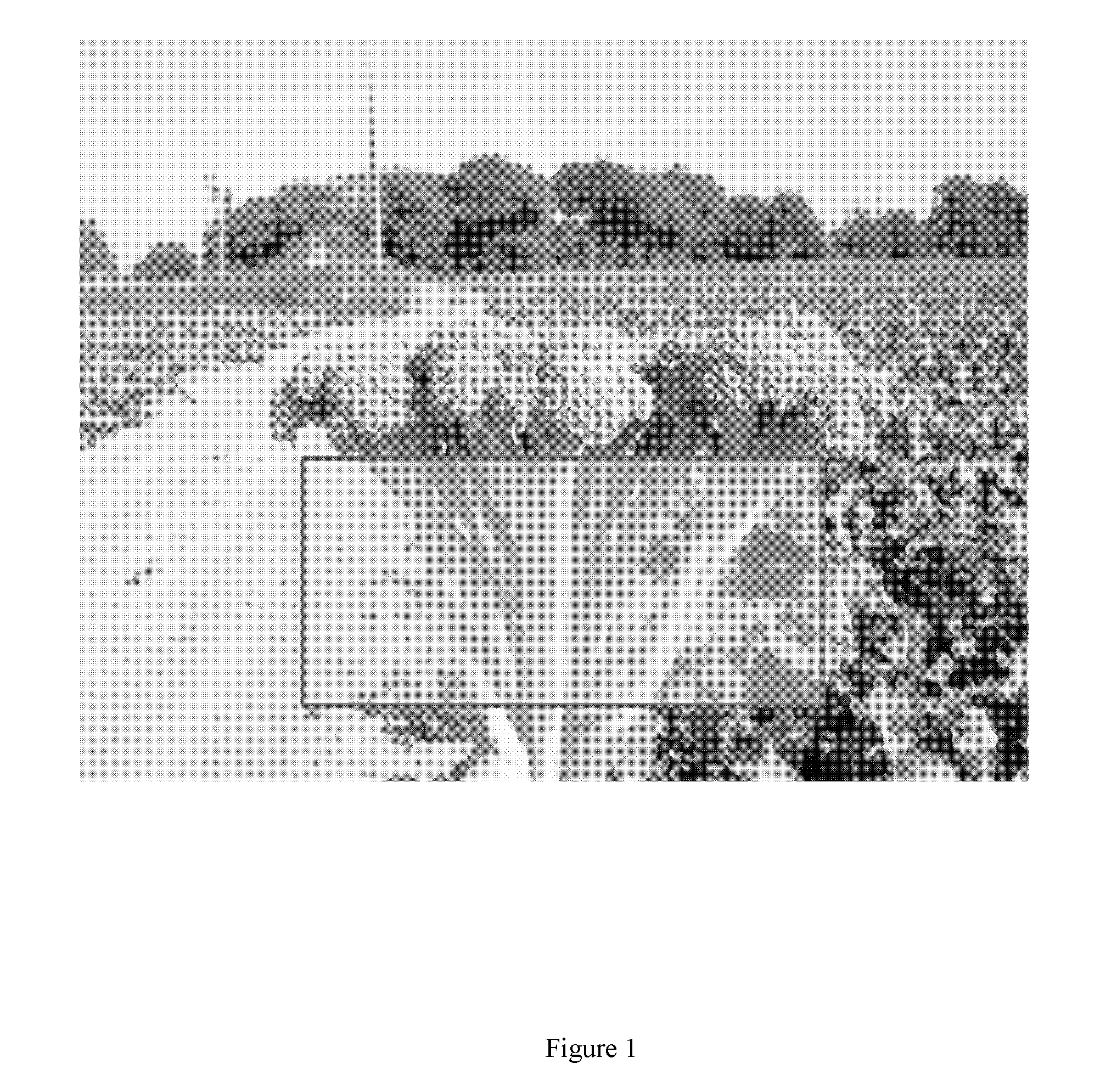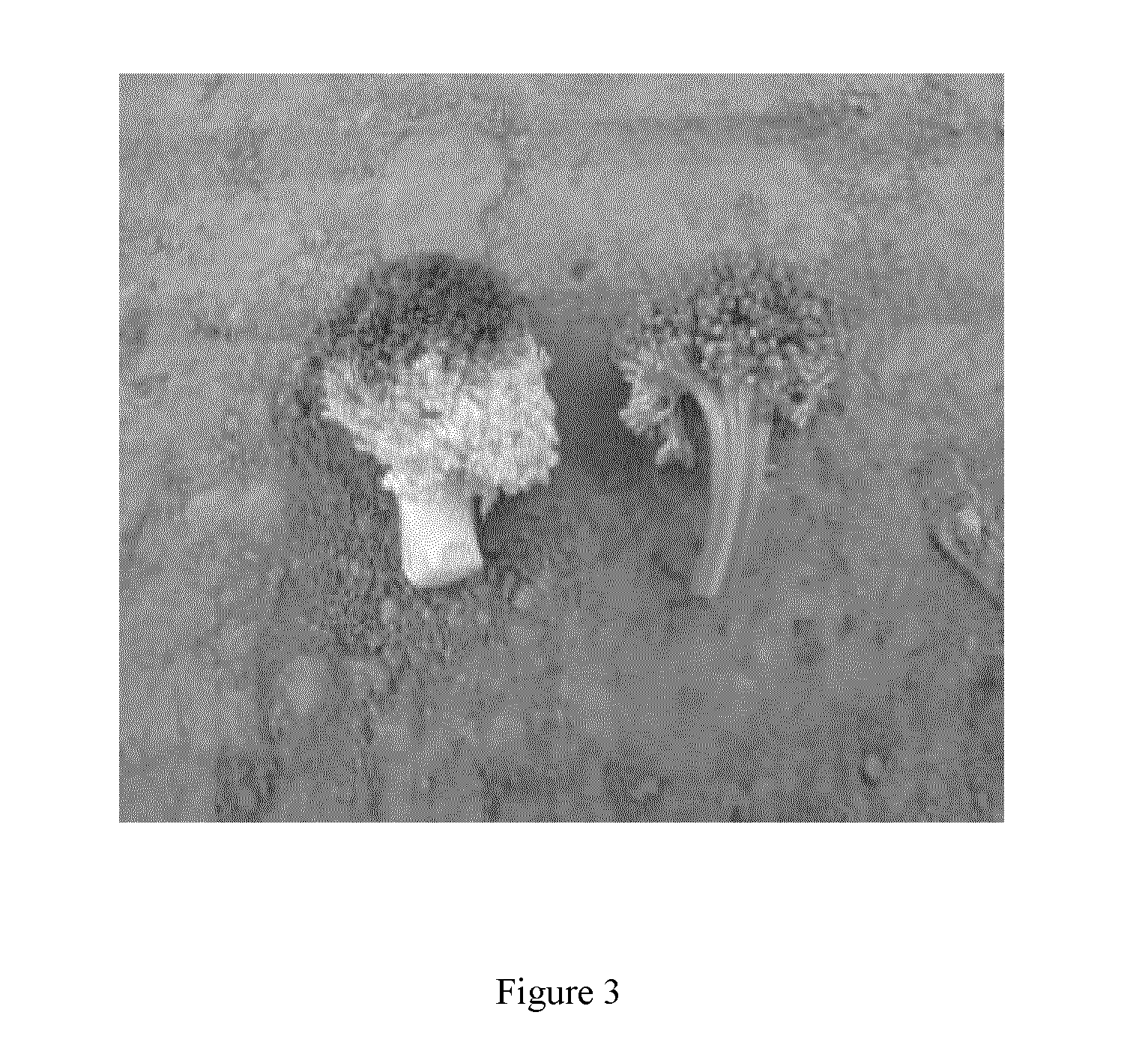Broccoli plant and use thereof
a broccoli plant and plant technology, applied in the field of new broccoli plants, can solve the problems of reducing the size of the head, affecting the growth of broccoli, so as to reduce the yellowing of broccoli, avoid the jamming of the cutting device, and improve the effect of sun exposur
- Summary
- Abstract
- Description
- Claims
- Application Information
AI Technical Summary
Benefits of technology
Problems solved by technology
Method used
Image
Examples
example 1
Brief Breeding History of Plant BR51512(01-7111-1 / 01-7229-1 x 00G028)
[0122]Female Breeding Selection
[0123]
01-7111 (357A / 91A005(S)) Gen 2 × 01-7229 (China Long F2 / / Sultan F8 / 099) Gen 1 2001F12002 single plant selectionF22003 single plant selectionF32004 single plant selectionF42005 single plant selectionF52006 selection of plant (01-7111-1 / 01-7229-1)
[0124]Plant 01-7111-1 / 01-7229-1 originated as a result of a cross of 01-7111 (proprietary accession) with 01-7229 (proprietary accession obtained by crossing of China Long F2 with Sultan F8).
[0125]The goal was to obtain a plant combining the multifloret trait of 01-7111 with protruding trait of 01-7229.
[0126]After selection and selfing for several generations, plant 01-7111-1 / 01-7229-1 was selected out with suitable very good multifloret trait with florets well arranged in a plane parallel to the ground leading to flat head.
[0127]Male Breeding Selection
[0128]
OSU 428 × (RB20)1-7-3 / 92-2684-1 2000F12001 single plant selectionF22002 single pl...
example 2
MF Breeding Scheme How to Build New MF Hybrids
[0136]It has been shown that it is possible to transfer the multifloret (MF) trait from the deposited line to more than one genetic background. In order to obtain a new MF hybrid from classic crown type lines, a cross was made between 2 new MF lines, one of which has good traits of crown type line A and the other has good traits of crown type line B.
[0137]For the development of a new MF line from crown type line A, a cross was made between the deposited MF line and a plant of crown type line A. The resulting 3 way hybrid was then backcrossed with the deposited MF line. In the BC1, plants for MF traits and good agronomic traits of line A were selected and selfed. This process was repeated a further 3 times. At the end of the process, a new fixed MF line with good traits of line A was obtained (BC1Fn). After each crossing step, broccoli plants which had a protruding head and having florets comprised within a plane substantially parallel to...
example 3
Features of Harvested Heads and Florets
[0140]The plant BR51512 has been planted in summer at a density of 40000 plants / hectare in Brittany. This plant shows good protruding trait with head above the leaf canopy and very good multifloret trait with florets well comprised within a horizontal plane (see FIGS. 1 and 2). The heads show good compactness, the stems and florets are extremely green and well adapted to mechanical harvesting.
[0141]Broccoli heads were harvested within a harvesting frame between day 61 and day 68 after planting. The average diameter of the head was 23 cm and the average weight of the head was 350 g. The average number of florets per head was 30 and the repartition by size was the following:
[0142]45% of the florets of diameter lower than 30 mm;
[0143]30% of the florets of diameter comprised between 30 and 45 mm;
[0144]20% of the florets of diameter comprised between 45 and 60 mm;
[0145]5% of the florets of diameter above 60 mm.
[0146]From the broccoli heads grown fro...
PUM
 Login to View More
Login to View More Abstract
Description
Claims
Application Information
 Login to View More
Login to View More - R&D
- Intellectual Property
- Life Sciences
- Materials
- Tech Scout
- Unparalleled Data Quality
- Higher Quality Content
- 60% Fewer Hallucinations
Browse by: Latest US Patents, China's latest patents, Technical Efficacy Thesaurus, Application Domain, Technology Topic, Popular Technical Reports.
© 2025 PatSnap. All rights reserved.Legal|Privacy policy|Modern Slavery Act Transparency Statement|Sitemap|About US| Contact US: help@patsnap.com



